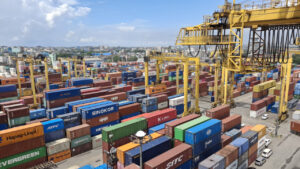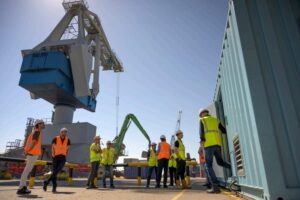Automation and other technologies crucial to port operations are not possible without networks strong enough to cope with the necessary data and this is where 5G is entering the picture.
Port Technology International’s webinar on ‘Port Automation and Digitialization’ explored LTE and 5G private wireless network connectivity and how it can help ports utilise smart technologies and remain competitive in an age where constantly increasing trade means supply chain connectivity is needed more than ever.
Consumer pressure and bigger vessel fleets mean ports are expected to handle an ever-increasing amount of cargo.
Additionally, this means ports have become data-heavy nodes in the supply chain, and the need to process containers more efficiently requires automation technology. However, it is increasingly clear that today’s WiFi networks cannot function sufficiently in a dynamic, highly demanding environment.
Ultimately, ports and container terminals must answer two productivity challenges: how do they increase moves per hour and how do they cut costs per move? The way to do this is to manage more data and connect its physical and digital assets, to improve what is known as ‘real-time decision making’.
This is vital because ports and terminals are complex hubs with permanent fleets of different technologies and systems. In many cases they are also are located close to cities, which adds to the challenges surrounding communication and connectivity.
In addition, as mentioned before, ships are getting bigger and carriers are dependent on ports and terminals being able to manage and process their cargo. Not only do ports have to handle the latest fleet of mega-ships, which can carry more than 23,000 TEU, but they must continue to serve the smaller-sized vessels and retain health and safety standards in the yards
“Vessels are getting bigger and productivity needs to meet the challenges,” Matthias Jablonowski, Head of Maritime, Nokia, said during the webinar. “Volumes can be dynamic, big vessels don’t come in every day and everything is under cost pressure.”
5G and wireless communications can help ports and terminals achieve these two goals by helping them on their digital transformation. This means providing terminal operating systems with more seamless connectivity and enabling for wireless, remote controlled rubber tyred gantry (RTG) cranes and straddle carriers and put infrastructure in place to make them move more freely throughout the container yard.
It also allows for concepts such as remote reefer monitoring and, in the future drone inspections of port traffic and machine conditions.
Another aspect is health and safety and connecting workers across the port, alerting them to dangerous situations and ensuring that the physical moving assets, such as Automated Guided Vehicles (AGVs) travel on their plotted course.
The webinar looked beyond these factors and explained exactly how port digitalization can be achieved through 5G and wireless communications.








